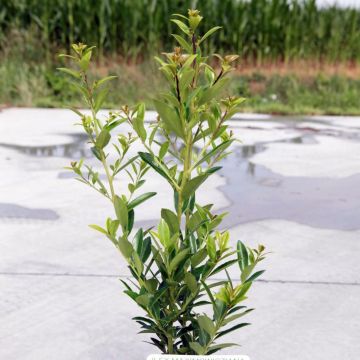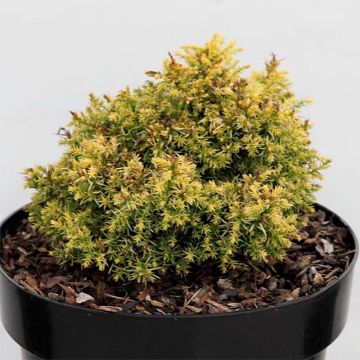

Ilex aquifolium - Common Holly


Ilex aquifolium - Common Holly


Ilex aquifolium - Common Holly
Ilex aquifolium - Common Holly
Ilex aquifolium
European Holly, Common Holly, English Holly, Evergreen Holly
Very beautiful young plant already producing lovely shoots of buds
Marie-Hélène, 24/04/2025
Special offer!
Receive a €20 voucher for any order over €90 (excluding delivery costs, credit notes, and plastic-free options)!
1- Add your favorite plants to your cart.
2- Once you have reached €90, confirm your order (you can even choose the delivery date!).
3- As soon as your order is shipped, you will receive an email containing your voucher code, valid for 3 months (90 days).
Your voucher is unique and can only be used once, for any order with a minimum value of €20, excluding delivery costs.
Can be combined with other current offers, non-divisible and non-refundable.
Home or relay delivery (depending on size and destination)
Schedule delivery date,
and select date in basket
This plant carries a 24 months recovery warranty
More information
We guarantee the quality of our plants for a full growing cycle, and will replace at our expense any plant that fails to recover under normal climatic and planting conditions.


Would this plant suit my garden?
Set up your Plantfit profile →
Description
The Ilex aquifolium is the Common Holly that needs no introduction. It is widespread throughout Europe, from Scandinavia to the Caucasus, southern Europe to North Africa, and Iran to northern Asia. This vast distribution area clearly highlights the remarkable adaptability of this bush. A bright shade-loving species with perfect form, it has been appreciated since time immemorial for its bright red berries that adorn the female plants in winter, perfectly enhanced by its dark and glossy prickly foliage. A symbol of our end-of-year celebrations, the Common Holly, highlighted in winter by a mantle of snow, is a great companion in most regions. Ornamental all year round, it will belong in a wild garden, a natural or defensive hedge or as a solitary plant.
Hollies belong to the Aquifoliaceae family. Ilex aquifolium is a ubiquitous evergreen bush, loving deep soils and cool to wet areas, but also adapting to open spaces. It has various forms, taking on the appearance of a large conical bush 5m (16.4 ft) tall and 2m (6.6 ft) wide, or the denser habit of a small tree, depending on its habitat. This slow-growing species deeply roots in the soil, establishing its root system before producing its branches. It is a large dioecious bush, meaning there are male and female individuals. The evergreen foliage is composed of tough leaves, 5 to 8cm (3.1in) long, taking different forms depending on the age or vigour of the plant. The leaf margin is undulate and dentate, with sharp spines, especially towards the bottom. The surface is dark green and very shiny on the upper side, much lighter and matte on the underside. Flowering occurs in spring, May-June, in the axils of the leaves, in the form of small white to pinkish, fragrant and nectar-rich flowers, not exceeding 5mm (0.2in) in diameter. Male flowers are clustered, while female flowers are solitary or grouped in 2 or 3. When pollination occurs, the female flowers transform into small globose and shiny fruits, ranging from dark red to scarlet, which are a delight for birds in winter. In the garden, birds scatter the seeds randomly, and it is not uncommon to see countless little hollies popping up here and there in flowerbeds and under large trees! The bark of this small tree is green when young, then turns grey and smooth. The Common Holly is a long-lived species, capable of living 400 to 500 years.
The Ilex aquifolium will please gardeners who appreciate sturdy, beautiful and unpretentious bushes all year round. It has the advantage of adapting to many growing conditions while adding architecture to the garden. It is majestic, especially in winter when its bright red fruits appear. It is perfect in a grove, accompanied by some deciduous shrubs with autumn foliage (Parrotia, Cotinus, Sorbus domestica...) and grey-blue conifers for contrast. It can also be planted in a mixed hedge, in the company of Elaeagnus Zempin, coyote willow (Salix exigua), Laurustinus, Cotoneaster lacteus, deciduous euonymus, or elderberries. It can be used to create defensive hedges with pyracanthas and Poncirus trifoliata. It dislikes dry air and shallow soils. Hardy beyond -15°C (5°F), it particularly enjoys cool places in a large natural garden. Plant it without moderation in cold regions, along with hawthorns, snowberries, and other evergreen hollies.
Hollies are a mix of loved and unknown plants. The genus includes nearly 800 deciduous or evergreen species, generally native to the temperate Northern Hemisphere. These ancient plants have experienced the alternation of glacial periods and dry and hot periods in our climatic history, making them extremely adaptable and resistant. Their wood, white to cream, is very low in water, even when green. It is dense and heavy but soft and easy to work in cabinetmaking. It is also an excellent fuel for heating, usable even when green. Finally, its foliage and berries (inedible) are rich in caffeine. A tea is prepared with its leaves in the Black Forest.
Ilex aquifolium - Common Holly in pictures




Plant habit
Flowering
Foliage
Botanical data
Ilex
aquifolium
Aquifoliaceae
European Holly, Common Holly, English Holly, Evergreen Holly
Western Europe
Other Ilex - Holly
View all →Planting and care
When planting common holly, incorporate some compost into your garden soil to allow for easier and deeper rooting. It is a species of undergrowth, found in plains and mountains, up to 1500m altitude, and tends to seek coolness in the southernmost regions of its distribution range. The common holly prefers slightly acidic soils and cool conditions, but can adapt to slightly chalky soils if the air humidity is sufficient. This bush also dislikes very cold conditions and icy winds. Therefore, choose a partially shaded location in a warm climate, and a more sunny location in a cool region. Water during the first 3 years, especially in summer and during prolonged droughts, to help the bush establish itself. It will then manage on its own and tolerate drought fairly well. In the first few years, prune in spring to shape the plant, selecting the branches you want to keep. Step back to observe your holly as a whole and determine the shape and arrangement of the stems.
Holly can become invasive where it thrives, through numerous spontaneous seedlings, as well as its ability to layer.
Holly can be attacked by holly leaf miners, white scale in spring, and mites and aphids in summer. Consider preventive treatment at the beginning of the season if necessary.
Planting period
Intended location
Care
Planting & care advice
-
, onOrder confirmed
Reply from on Promesse de fleurs
Similar products
Haven't found what you were looking for?
Hardiness is the lowest winter temperature a plant can endure without suffering serious damage or even dying. However, hardiness is affected by location (a sheltered area, such as a patio), protection (winter cover) and soil type (hardiness is improved by well-drained soil).

Photo Sharing Terms & Conditions
In order to encourage gardeners to interact and share their experiences, Promesse de fleurs offers various media enabling content to be uploaded onto its Site - in particular via the ‘Photo sharing’ module.
The User agrees to refrain from:
- Posting any content that is illegal, prejudicial, insulting, racist, inciteful to hatred, revisionist, contrary to public decency, that infringes on privacy or on the privacy rights of third parties, in particular the publicity rights of persons and goods, intellectual property rights, or the right to privacy.
- Submitting content on behalf of a third party;
- Impersonate the identity of a third party and/or publish any personal information about a third party;
In general, the User undertakes to refrain from any unethical behaviour.
All Content (in particular text, comments, files, images, photos, videos, creative works, etc.), which may be subject to property or intellectual property rights, image or other private rights, shall remain the property of the User, subject to the limited rights granted by the terms of the licence granted by Promesse de fleurs as stated below. Users are at liberty to publish or not to publish such Content on the Site, notably via the ‘Photo Sharing’ facility, and accept that this Content shall be made public and freely accessible, notably on the Internet.
Users further acknowledge, undertake to have ,and guarantee that they hold all necessary rights and permissions to publish such material on the Site, in particular with regard to the legislation in force pertaining to any privacy, property, intellectual property, image, or contractual rights, or rights of any other nature. By publishing such Content on the Site, Users acknowledge accepting full liability as publishers of the Content within the meaning of the law, and grant Promesse de fleurs, free of charge, an inclusive, worldwide licence for the said Content for the entire duration of its publication, including all reproduction, representation, up/downloading, displaying, performing, transmission, and storage rights.
Users also grant permission for their name to be linked to the Content and accept that this link may not always be made available.
By engaging in posting material, Users consent to their Content becoming automatically accessible on the Internet, in particular on other sites and/or blogs and/or web pages of the Promesse de fleurs site, including in particular social pages and the Promesse de fleurs catalogue.
Users may secure the removal of entrusted content free of charge by issuing a simple request via our contact form.
The flowering period indicated on our website applies to countries and regions located in USDA zone 8 (France, the United Kingdom, Ireland, the Netherlands, etc.)
It will vary according to where you live:
- In zones 9 to 10 (Italy, Spain, Greece, etc.), flowering will occur about 2 to 4 weeks earlier.
- In zones 6 to 7 (Germany, Poland, Slovenia, and lower mountainous regions), flowering will be delayed by 2 to 3 weeks.
- In zone 5 (Central Europe, Scandinavia), blooming will be delayed by 3 to 5 weeks.
In temperate climates, pruning of spring-flowering shrubs (forsythia, spireas, etc.) should be done just after flowering.
Pruning of summer-flowering shrubs (Indian Lilac, Perovskia, etc.) can be done in winter or spring.
In cold regions as well as with frost-sensitive plants, avoid pruning too early when severe frosts may still occur.
The planting period indicated on our website applies to countries and regions located in USDA zone 8 (France, United Kingdom, Ireland, Netherlands).
It will vary according to where you live:
- In Mediterranean zones (Marseille, Madrid, Milan, etc.), autumn and winter are the best planting periods.
- In continental zones (Strasbourg, Munich, Vienna, etc.), delay planting by 2 to 3 weeks in spring and bring it forward by 2 to 4 weeks in autumn.
- In mountainous regions (the Alps, Pyrenees, Carpathians, etc.), it is best to plant in late spring (May-June) or late summer (August-September).
The harvesting period indicated on our website applies to countries and regions in USDA zone 8 (France, England, Ireland, the Netherlands).
In colder areas (Scandinavia, Poland, Austria...) fruit and vegetable harvests are likely to be delayed by 3-4 weeks.
In warmer areas (Italy, Spain, Greece, etc.), harvesting will probably take place earlier, depending on weather conditions.
The sowing periods indicated on our website apply to countries and regions within USDA Zone 8 (France, UK, Ireland, Netherlands).
In colder areas (Scandinavia, Poland, Austria...), delay any outdoor sowing by 3-4 weeks, or sow under glass.
In warmer climes (Italy, Spain, Greece, etc.), bring outdoor sowing forward by a few weeks.



























































